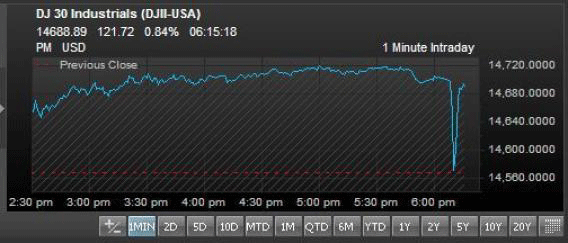The AP Twitter hack: Wall Street's tweet-scraping technology that sparked a 145-point nosedive
A fake explosion at the White House sent the market into free fall on Tuesday, the result of increasingly popular headline-monitoring software

Shortly after the clock struck noon on the East Coast Tuesday, a jaw-dropping tweet was posted to The Associated Press' Twitter account: "Breaking: Two Explosions in the White House and Barack Obama is injured." The news ricocheted through Twitter like a pinball before it was soon discovered that the AP's account had been compromised by hackers. A collective of pro-Assad digital instigators known as the Syrian Electronic Army soon claimed responsibility.
Within seconds of the fracas, the Dow Jones Industrial Average plummeted 145 points (see the graphic below) before picking itself back up a few minutes later. The Wall Street Journal took a close look at how the nosedive was instigated by technology — sophisticated computer-trading software that monitors news headlines, corporate announcements, and yes, even social media to make buy or sell decisions in fractions of a second. Welcome to the world of algorithm-based decision-making.

The Journal's Geoffrey Rogow and Telis Demos report:
The Week
Escape your echo chamber. Get the facts behind the news, plus analysis from multiple perspectives.

Sign up for The Week's Free Newsletters
From our morning news briefing to a weekly Good News Newsletter, get the best of The Week delivered directly to your inbox.
From our morning news briefing to a weekly Good News Newsletter, get the best of The Week delivered directly to your inbox.
The technology has been around for several years, but it is increasingly finding adherents among financial firms, including hedge funds, investment banks, and even long-term investors such as mutual-fund companies. Experts say traders use the data for just about every kind of investment around the world, from U.S. stocks to the Korean won. [Wall Street Journal]
Tuesday's fire sale was triggered by a few charged keywords, namely terms like "explosion" and "White House." Once that information was sifted into crunchable data, it was beamed out to clients — including hedge funds and government agencies — from a Manhattan-based startup called Dataminr, which bills itself as an "analytics engine" that "transforms social media streams into actionable signals."
Once Dataminr's distress signals were received, the firms' proprietary software exploded into action, ready to sell. The whole process occurred in the blink of an eye.
Dow Jones — which publishes The Journal — claims these "elementized" news feeds "cut execution times and perform deeper analysis" than traditional methods. In addition to scanning hundreds of millions of tweets and headlines, they take into account several additional factors, including the reputation of a news source (in this case a tweet from the AP's confirmed account) and a tweet's geo-location. Media firms, including Dow Jones, Bloomberg, and Reuters, have been using elementized news feeds in some capacity since 2006.
And while it may feel gratifying to point fingers at the machines' mathematical inability to preemptively sniff out a hoax, The Journal notes that Dataminr's computers were quick to right a wrong. A second alert warning clients that the initial news may not have been accurate was sent out almost immediately, even before the AP had a chance to announce it had been hacked. Five minutes after the fake White House explosion sent the market into free fall, "shares rebounded across the board, and the blue-chip index ended the day with gains greater than before the incident."
A free daily email with the biggest news stories of the day – and the best features from TheWeek.com
-
 Political cartoons for December 17
Political cartoons for December 17Cartoons Wednesday's political cartoons include healthcare costs, the affordability hoax, giving up pencils, and more
-
 Trump vs. BBC: what’s at stake?
Trump vs. BBC: what’s at stake?The Explainer The US president has filed a $10 billion lawsuit over the editing of Panorama documentary, with the broadcaster vowing to defend itself
-
 Animal Farm: has Andy Serkis made a pig’s ear of Orwell?
Animal Farm: has Andy Serkis made a pig’s ear of Orwell?Talking Point Animated adaptation of classic dystopian novella is light on political allegory and heavy on lowbrow gags